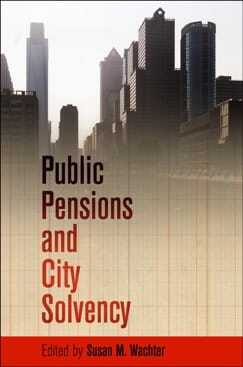Public Pensions and City Solvency
Edited by Susan M. Wachter
University of Pennsylvania Press
3905 Spruce Street,
Philadelphia, PA 19104-4112;
www.upenn.edu/pennpress.
2016. 104 pages. Hardcover, $24.95.
As municipal and state governments outline their potential pension woes, the picture is generally grim—a Pew study concluded that, taken together, unfunded liabilities total nearly $100 billion at the city level and nearly $1 trillion at the state level. But all these estimates may yet be too optimistic.
As researcher Joshua D. Rauh lays out in the first chapter of Public Pensions and City Solvency, edited by Susan M. Wachter, a professor at the Wharton School and the Penn School of Design, the total cost of U.S. pension shortfalls may exceed $4 trillion. In cities with underfunded systems, such as Chicago, municipal pension obligations could total nearly $40,000 per household. If these funds were to collapse, cities would be contractually obligated to dedicate upwards of one-third of their annual operating budgets to cover benefits.
Rauh’s research in the book—fittingly assembled in Philadelphia, a city with an estimated $5.3 billion pension gap—lays out something of a theme across each of the four differently authored chapters: the gap between discussions about pensions and reality.
Booming stock markets in recent years have buoyed pension funds, leading some cities to even pay out bonuses, but these days could be ending. More worryingly, as Rauh argues, costs caused by historical gaps between liabilities and assets translated into a 5 percent growth nationally in overall pension liabilities from 2009 to 2013, as stock markets roared back from the Great Recession and many funds saw strong annual returns. Even this largesse was a fiction.
Pensions, in their modern context, are partially a product of political delusion. The rise of 1970s conservatism led to a generation of politicians who wanted to publicly appear tough on public sector unions by keeping government salaries low. But in private, they mollified unions by promising benefits and retirement packages whose full costs would be borne decades later.
In one of its most compelling segments, the book lays out the important intersection of long-deferred infrastructure maintenance and burgeoning pension needs. Just as cities confront the silent financial crisis posed by pension obligations, they also face the highly visible consequences of crumbling water mains, streets, and transit systems that could further jeopardize the fragile growth many American cities have witnessed in recent years.
These points may seem obvious, but for the public conversation around pensions to ever evolve, which is explicitly what this book asserts that it has set out to do, the issue must be taken beyond ledger sheets and government budget meetings. Often regarded as comically boring, pensions must be made real and gripping for the public.
Public Pensions does include a bevy of interpretable recommendations, albeit some more convincing than others. Nearly every chapter goes out of its way to dispel the myth of municipal bankruptcy as an “easy out,” or the unfair and unconstitutional notion that cities might simply renege on pension liabilities that were legitimately earned by government workers.
Along with structural recommendations to ease new workers into deferred annuity plans—a more stable retirement plan common in some Scandinavian countries—and reform cost-of-living adjustments (which make up fully half of cities’ future liabilities), the book emphasizes that the erosion of municipal finances in the 20th century must also be reversed. Attracting new residents and business, essentially rebuilding local tax bases with new development and investment, is just as important to resolving the pension problem.
Despite the massive undertakings any fix would entail, the contributors are generally optimistic that this crushing problem is not unsolvable. The book wisely stops short of prescribing a single set of “best practices” for every city, but on one point it is unwavering: governments will be forced to confront the pension crisis sooner rather than later.
Ryan Briggs has covered politics and development issues for Philadelphia City Paper, Hidden City, Next City, and Metropolis.





